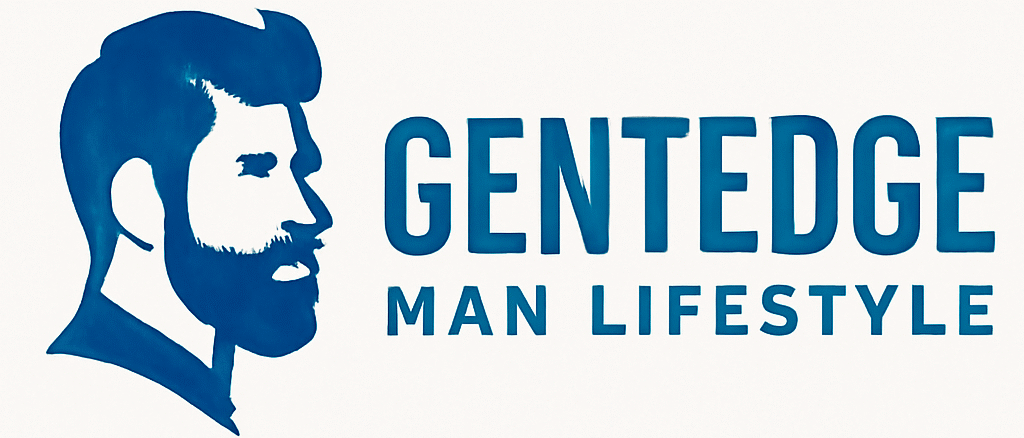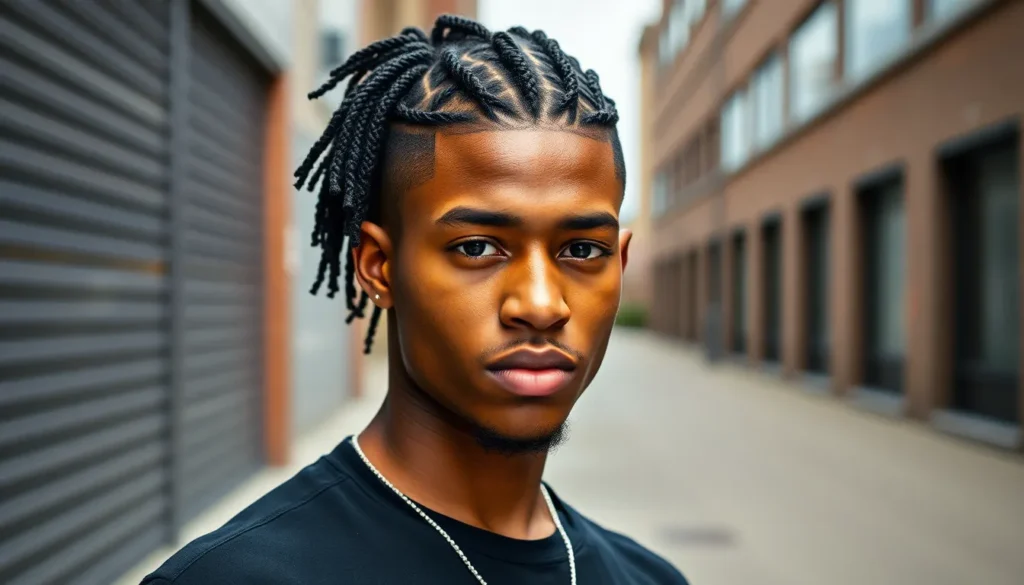Men’s hairstyles have evolved dramatically over the past decade and braids with fades represent one of the most striking combinations we’ve seen. This ever-changing pairing merges traditional braiding techniques with modern barbering precision creating looks that are both culturally rich and contemporary fresh.
We’ve witnessed countless men transform their appearance by combining intricate braids with clean fade cuts. Whether you’re drawn to cornrows that flow into a sharp skin fade or box braids that contrast beautifully with tapered sides the possibilities are endless. These styles work exceptionally well for men with textured hair who want to showcase their natural texture while maintaining a polished professional appearance.
The versatility of braids with fades makes them perfect for any lifestyle. From corporate boardrooms to creative studios these looks adapt seamlessly to your environment. We’ll explore the most popular braid and fade combinations maintenance tips and styling techniques that’ll help you achieve the perfect look for your face shape and personal style.
Classic Box Braids With Low Fade
Box braids paired with a low fade create a timeless look that balances traditional African styling with contemporary barbering precision. This combination offers the perfect entry point for men exploring braided hairstyles while maintaining a professional appearance.
Choosing the Right Braid Size
Medium-sized box braids work best for beginners transitioning into braided styles with fades. We recommend braids measuring approximately 1/2 to 3/4 inches in width for optimal visual balance with low fade cuts. Smaller braids require more maintenance time but offer intricate detailing that complements the subtle fade transition.
Consider your hair density when selecting braid dimensions for fade combinations. Dense hair supports smaller braids without appearing sparse while fine hair benefits from medium to larger braids that create fuller visual impact. Your barber can assess your natural hair texture to determine the most flattering braid size.
Face shape influences the ideal braid proportions for low fade styles. Round faces benefit from medium braids that add vertical lines while square faces work well with varied braid sizes that soften angular features. Oval faces accommodate most braid dimensions making this face shape the most versatile for experimentation.
Maintenance Tips for Longevity
Sleep protection extends the lifespan of box braids with low fade cuts significantly. We suggest using silk or satin pillowcases to reduce friction that causes frizzing and premature loosening. Wrap braids in a silk scarf before bed to maintain the crispness of both the braided sections and fade lines.
Weekly scalp care keeps both braided and faded areas healthy throughout the style’s duration. Apply lightweight oils like jojoba or argan oil directly to the scalp using a spray bottle or applicator tip. Focus on the transition area where braids meet the fade to prevent dryness and irritation.
Touch-up scheduling maintains the sharp contrast between braids and fade that defines this classic style. Book fade touch-ups every 2-3 weeks to preserve clean lines while the braids typically last 6-8 weeks with proper care. Professional maintenance ensures the style remains fresh and well-defined throughout its wear period.
French Braids With High Fade
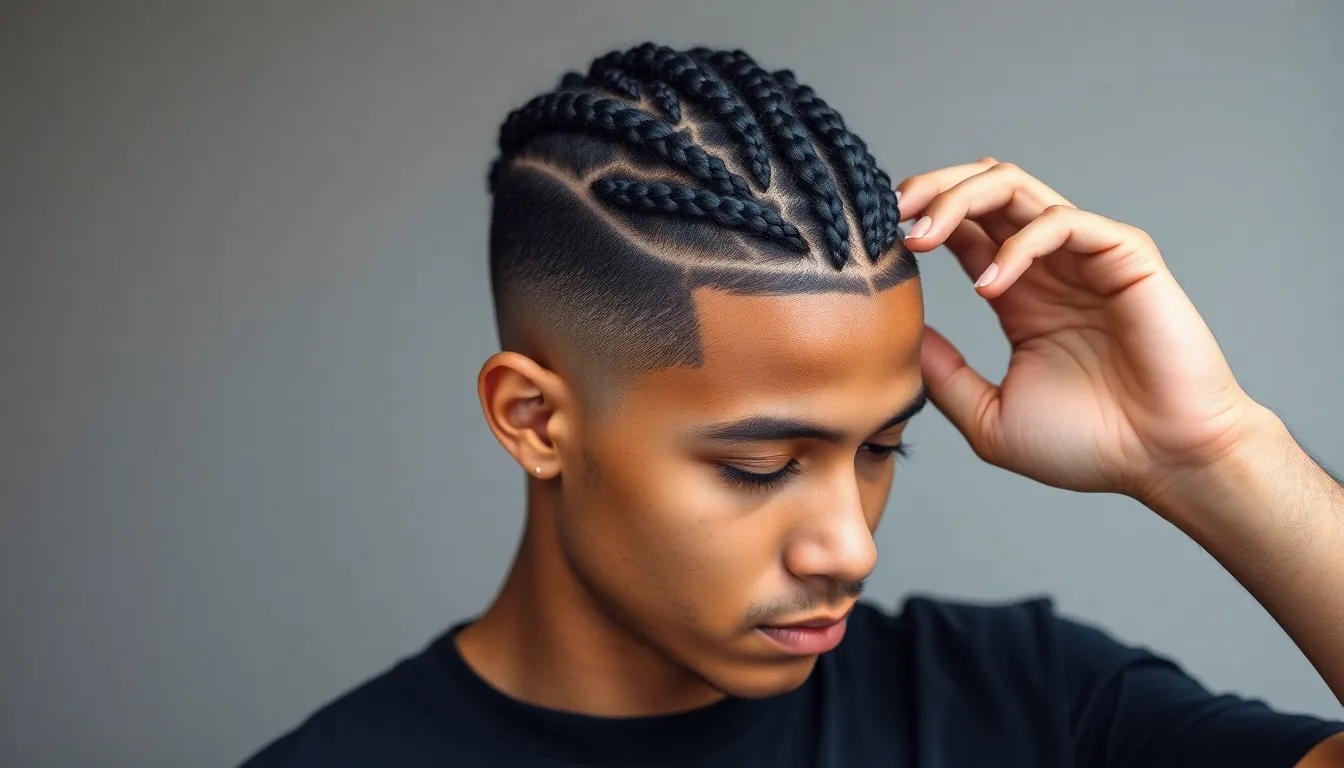
We’ve seen how classic box braids work beautifully with low fades, but french braids with high fades create an even more dramatic contrast. This combination delivers sharp precision where the high fade transitions from very short sides to the intricate braided sections on top.
Single French Braid Technique
Creating a single french braid starts at the front hairline and gradually incorporates side hair as we work toward the back. We cross strands over the middle section while continuously weaving in new hair from each side before crossing over. Proper finger positioning becomes essential when managing multiple strands without dropping them during the braiding process.
Running our hand down each strand after adding new hair prevents unwanted tangling throughout the technique. The method produces a tight, neat braid that sits prominently atop the head. Heat protection products applied before styling help maintain hair health during the blow drying preparation phase.
Edge control products smooth flyaways and define clean sections for professional looking results. We recommend leaving some length at braid ends to enable styling into buns or other creative shapes without unraveling issues.
Double French Braid Styling
Double french braids split the top hair into two equal sections for parallel braiding on each side. We apply the same crossing and weaving technique twice to create symmetrical braids that enhance the high fade’s clean appearance. This method offers versatility through various finishing options like twin buns, ponytails, or tucked under styles for lower profiles.
Sectioning accuracy determines the final look’s balance and symmetry across both braided sections. The dual braid approach works particularly well on longer hair lengths where we have adequate material for substantial braiding. Clean faded sides highlight the geometric precision of parallel french braids above.
Styling products applied during the braiding process help maintain definition and prevent frizz throughout wear time. We can adjust braid tightness based on comfort preferences while ensuring the structure remains secure against the contrasting fade backdrop.
Cornrows With Mid Fade

Cornrows paired with a mid fade create one of the most balanced braid styles available, offering versatility that works across different hair textures and face shapes. This combination delivers the perfect middle ground between subtle low fades and dramatic high fades.
Straight Back Cornrow Patterns
Straight back cornrows represent the foundation of classic cornrow styling, featuring braids that run directly from your hairline to the crown in perfectly parallel lines. We recommend spacing these braids approximately 1/2 to 3/4 inches apart for optimal visual balance with mid fades. The geometric precision of straight patterns complements the gradual taper of mid fades exceptionally well.
Creating straight back patterns requires sectioning your hair into even horizontal lines using a rat tail comb. Start each braid at the front hairline and maintain consistent tension throughout the braiding process. The mid fade enhances these clean lines by providing a sharp contrast at the temples and ears, making the braided sections appear more defined and structured.
Professional barbers often trim the fade to begin approximately 2 inches above the ears, gradually blending upward to meet the braided crown area. This placement creates maximum visual impact while maintaining the classic appeal of straight back cornrows. Regular maintenance every 3 to 4 weeks keeps both the braids and fade looking crisp and well defined.
Zigzag and Curved Designs
Zigzag and curved cornrow patterns transform traditional braiding into artistic expression, featuring braids that follow winding paths and geometric shapes across your scalp. These intricate designs require advanced braiding skills but create stunning visual effects when paired with mid fades. The contrasting fade background emphasizes every curve and angle of your chosen pattern.
Popular zigzag variations include diamond patterns, wave designs, and interconnected geometric shapes that showcase braiding craftsmanship. We suggest starting with simpler curved patterns before attempting complex zigzag designs, as precision becomes crucial for achieving symmetrical results. The mid fade acts as a neutral canvas that highlights the creativity and complexity of your chosen pattern.
Curved designs flow naturally from front to back, creating movement and visual interest that works particularly well with oval and square face shapes. These patterns typically take 2 to 3 hours to complete professionally, depending on the complexity of your chosen design. Pinterest and YouTube feature countless pattern variations that demonstrate the artistic possibilities available with cornrows and mid fade combinations.
Maintenance for intricate patterns requires careful attention to preserve the original design integrity. Touch up your mid fade every 2 to 3 weeks while keeping the braided patterns intact for 4 to 6 weeks total wear time.
Dutch Braids With Skin Fade
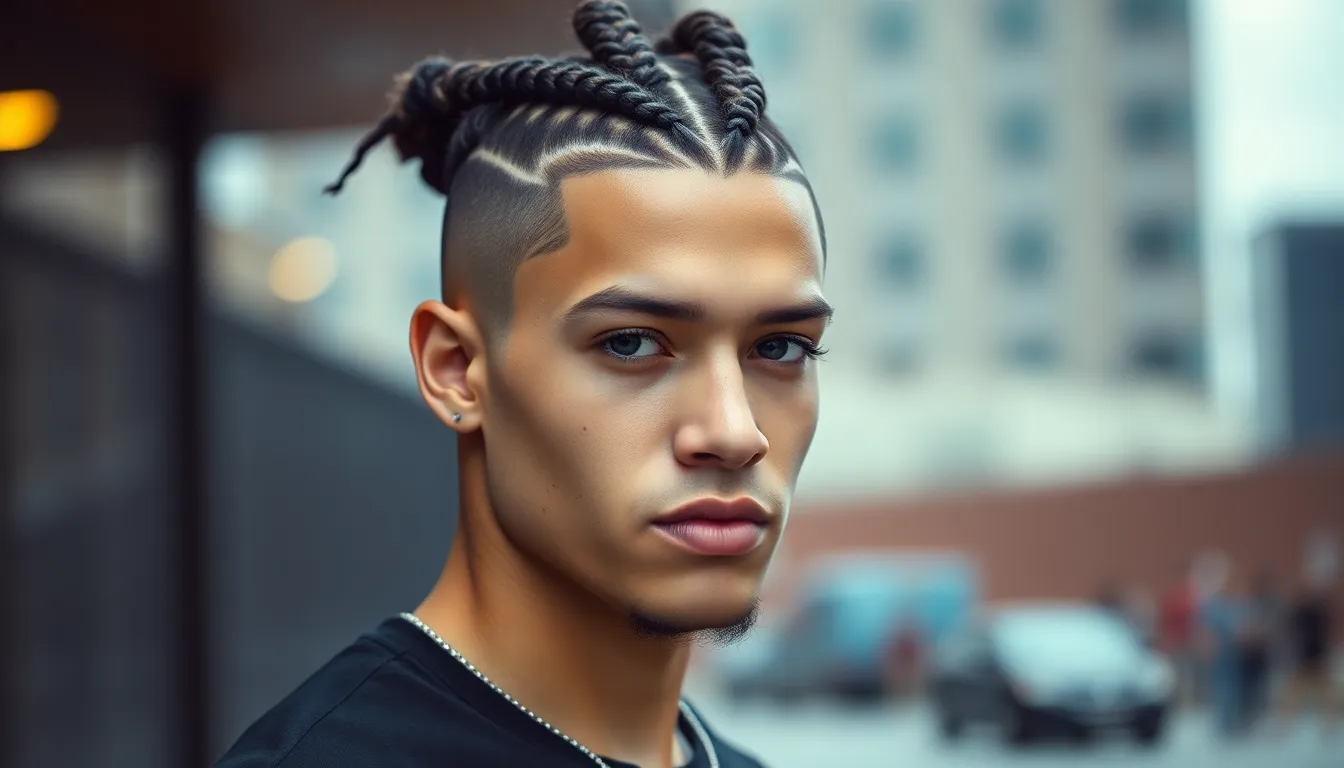
Dutch braids with skin fade represent one of our most texturally ever-changing combinations, where the inverted braiding technique creates striking three-dimensional effects against the ultra-clean backdrop of a skin fade. This pairing maximizes visual contrast while delivering exceptional versatility for modern men’s styling.
Creating Volume and Texture
Dutch braids naturally build volume by crossing strands under instead of over, creating a raised effect that sits prominently above the scalp. We achieve maximum texture by maintaining consistent tension throughout the braiding process, ensuring each crossover section remains uniform and well-defined. The skin fade amplifies this dimensional quality by creating a stark contrast that makes the braided sections appear more voluminous and prominent.
Starting with slightly damp hair helps us manipulate the strands more effectively while building the desired texture. We recommend sectioning the hair into 2-3 parallel lines, depending on head size and desired thickness, with each section measuring approximately 1 to 1.5 inches wide. The inverted crossing technique requires practice to master, but the results deliver unmatched depth and visual interest compared to traditional braiding methods.
Texture enhancement becomes particularly noticeable when we combine multiple Dutch braids with varying thicknesses. Alternating between standard and mini Dutch braids creates a ever-changing pattern that plays beautifully against the clean skin fade backdrop. This technique works exceptionally well for men with medium to thick hair density, as the volume created by Dutch braiding balances perfectly with the graduated fade.
Styling Products for Hold
Hair gel provides the strongest foundation for maintaining Dutch braids with skin fade, offering long-lasting hold while defining the edges where braids meet the faded sections. We apply a moderate amount of gel to each section before braiding, working it through from roots to ends to ensure consistent hold throughout the style. Edge control becomes essential for crisp definition along the hairline and fade transitions, creating sharp boundaries that enhance the overall precision of the look.
Strong hold pomade works exceptionally well for men who prefer a slightly more flexible finish while maintaining structure. We distribute pomade evenly through towel-dried hair, focusing on the areas that will be braided while avoiding oversaturation that could weigh down the final result. The combination of pomade and light gel application creates optimal conditions for both braiding manipulation and lasting hold.
Texturizing spray applied before braiding adds grip and definition, making it easier to achieve tight, uniform Dutch braids that won’t slip or loosen throughout the day. We mist each section lightly before beginning the braiding process, allowing the product to activate while we work. This pre-styling step proves particularly valuable for men with fine or slippery hair textures that typically resist traditional braiding techniques.
Finishing with a light mist of flexible hold hairspray locks in the completed style while maintaining the natural movement that makes Dutch braids so visually appealing. We focus the spray application on the braided sections rather than the skin fade areas, preserving the clean contrast that defines this distinctive combination.
Man Bun Braids With Taper Fade
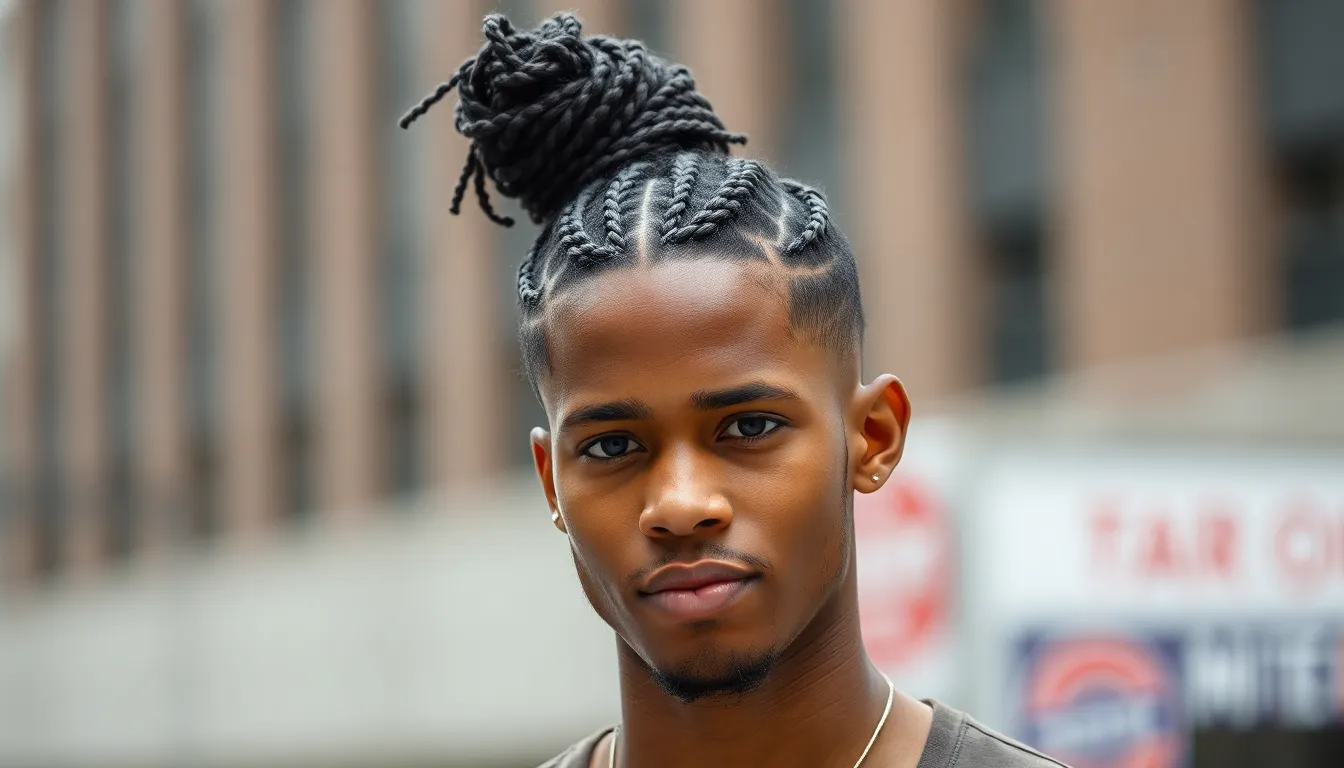
Man Bun Braids With Taper Fade represent the perfect evolution from our previous fade and braid combinations, offering a sophisticated updo style that maintains clean sides and back. This elevated approach transforms traditional braiding into a versatile updo that works exceptionally well in professional settings while preserving cultural authenticity.
Top Knot Braid Combinations
Top knot braids work exceptionally well when we combine multiple braiding techniques into a single elevated style. We recommend starting with 3-4 individual braids that converge at the crown, creating a structured foundation for the knot formation. French braids leading into a top knot provide the most secure hold, especially when paired with a high taper fade that emphasizes the braided elevation.
Double strand twist combinations offer another ever-changing approach to top knot styling. We create 6-8 twisted sections that spiral upward, then secure them into a compact knot positioned 2-3 inches above the natural hairline. This technique works particularly well with medium to thick hair textures, providing enough volume to create an impressive top knot silhouette.
Cornrow top knots deliver maximum definition and longevity in updo styling. We braid 4-6 cornrows from the hairline backward, then gather and twist them into a tight knot at the crown. The taper fade enhances this look by creating clean contrast between the detailed braiding work and the precisely cut sides, making the top knot appear more prominent and structured.
Loose vs. Tight Braiding Techniques
Loose braiding techniques create a more relaxed aesthetic perfect for casual environments and everyday wear. We recommend maintaining 70-80% tension during the braiding process, allowing for natural movement and flexibility in the finished style. This approach works exceptionally well with taper fades because the relaxed braids provide textural contrast against the sharp precision of the fade cut.
Tight braiding delivers maximum longevity and formal appearance, ideal for professional settings and special occasions. We apply consistent 90-95% tension throughout the braiding process, creating defined sections that maintain their shape for 6-8 weeks. The sleek appearance of tight braids pairs perfectly with taper fades, producing a modern and sophisticated overall look.
Hair texture considerations significantly impact our braiding tension choices. Coarse hair textures handle tight braiding better and maintain definition longer, while fine hair responds better to moderate tension to prevent breakage. We adjust our braiding pressure based on individual hair characteristics, ensuring optimal results regardless of natural texture.
Styling product application varies between loose and tight braiding approaches. For loose braids, we use lightweight leave in conditioners and natural oils to maintain flexibility. Tight braiding requires stronger hold products like hair gel and edge control to maintain definition and prevent frizz throughout the wear period.
Micro Braids With Burst Fade

Micro braids paired with a burst fade represent one of the most intricate combinations in modern men’s styling. This sophisticated technique creates small, detailed braids while maintaining the curved fade pattern that radiates from behind the ears.
Sectioning Hair Properly
Creating precise sections forms the foundation of successful micro braids with burst fades. We recommend dividing your hair into small, uniform squares measuring approximately 1/4 to 1/2 inch each for optimal micro braid definition.
Start by mapping out your sectioning pattern before you begin braiding. Use a rat tail comb to create clean, straight parts that follow the natural direction of your hair growth. Clip away completed sections to maintain organization throughout the braiding process.
Work systematically from the crown area downward, ensuring each section remains consistent in size. Maintain parallel lines between sections to create the geometric precision that complements the burst fade’s curved lines. Check your sectioning pattern frequently by stepping back to assess overall symmetry and balance.
Apply a small amount of styling gel to each section before braiding to reduce flyaways and maintain clean part lines. Keep sectioned hair slightly damp throughout the process to ensure easier manipulation and tighter braid formation.
Time Investment and Patience
Completing micro braids with a burst fade typically requires 4 to 6 hours depending on hair density and desired braid size. We’ve found that rushing this process leads to uneven sections and inconsistent braid tension throughout the style.
Schedule your braiding session when you have uninterrupted time available. Break the process into manageable segments, focusing on completing one section at a time rather than attempting to finish everything in one sitting. Take regular breaks every hour to prevent hand fatigue and maintain consistent braiding quality.
Practice your micro braiding technique on small sections before committing to the full style. Master the three strand braiding motion until it becomes second nature, allowing you to maintain consistent tension throughout each braid. Prepare your workspace with all necessary tools including sectioning clips, styling products, and a comfortable chair.
Expect the initial learning curve to extend your time investment significantly. Allow extra time for your first few attempts as you develop muscle memory and refine your sectioning accuracy. Consider enlisting help from an experienced braider for your first micro braid and burst fade combination to learn proper technique and timing.
Fishtail Braids With Drop Fade
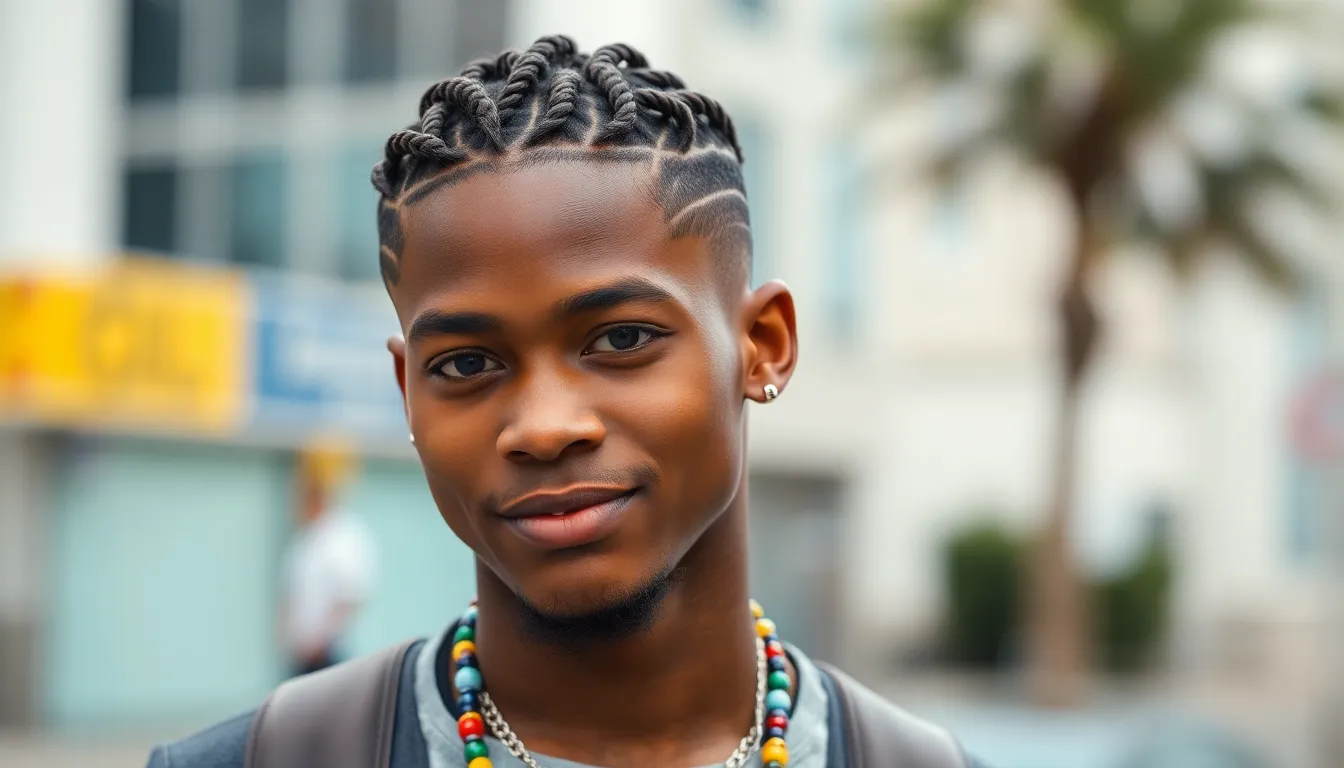
Fishtail braids with drop fades represent the perfect marriage of intricate artistry and contemporary barbering precision. This sophisticated combination creates a stunning visual contrast between the detailed woven pattern on top and the expertly curved fade that follows your natural hairline.
Step-by-Step Braiding Process
Prepare your hair by washing and detangling thoroughly before starting the braiding process. Clean hair provides better grip and creates more defined fishtail patterns that complement the drop fade’s sharp lines.
Section the top portion into your desired number of braids, typically 2-4 sections depending on your hair density and preferred look. Each section should be wide enough to create substantial fishtail braids that won’t get lost against the dramatic drop fade.
Split each section into two equal parts to begin the fishtail technique. This foundational step ensures your braids will have the characteristic interwoven appearance that makes fishtail braids so visually striking.
Cross small strands from the outside of one section to the inside of the opposite section, alternating sides consistently. This crossing motion creates the distinctive fishtail pattern that resembles overlapping scales.
Maintain consistent tension throughout the braiding process to ensure even, well-defined fishtail braids. Loose sections will appear messy against the precision of your drop fade, while overly tight braiding can cause discomfort and breakage.
Secure each braid with small rubber bands or hair ties that match your hair color. Clear elastics work well for most hair types and won’t distract from the overall aesthetic.
Fade the sides and back with clippers, starting from a high point and curving around your ears and neckline. The drop fade’s curved silhouette enhances the fishtail braids’ intricate details by creating a clean, modern backdrop.
Adding Accessories and Beads
Thread beads onto your fishtail braids before securing the ends for the easiest application. Choose beads with holes large enough to accommodate your hair thickness but small enough to stay secure during daily activities.
Select complementary colors that enhance your natural hair tone or match your personal style preferences. Gold and silver cuffs provide a sophisticated accent, while colorful beads create a more playful, artistic expression.
Position accessories strategically along the length of your braids rather than clustering them at the ends. This distribution creates visual interest and prevents the weight from pulling on your hair roots.
Add small clips or decorative elastics at various points along your fishtail braids to create texture and dimension. These accessories work particularly well with longer braids that extend past your shoulders.
Consider hair jewelry like thin metal rings or decorative wire wraps that can be woven through your fishtail braids. These elements add shine and movement that contrasts beautifully with the matte finish of your drop fade.
Experiment with different textures by mixing smooth beads with textured ones, or combining metal accessories with natural materials like wood or stone. This variety creates visual depth that enhances the overall sophistication of your fishtail braids with drop fade.
Viking Braids With Undercut Fade
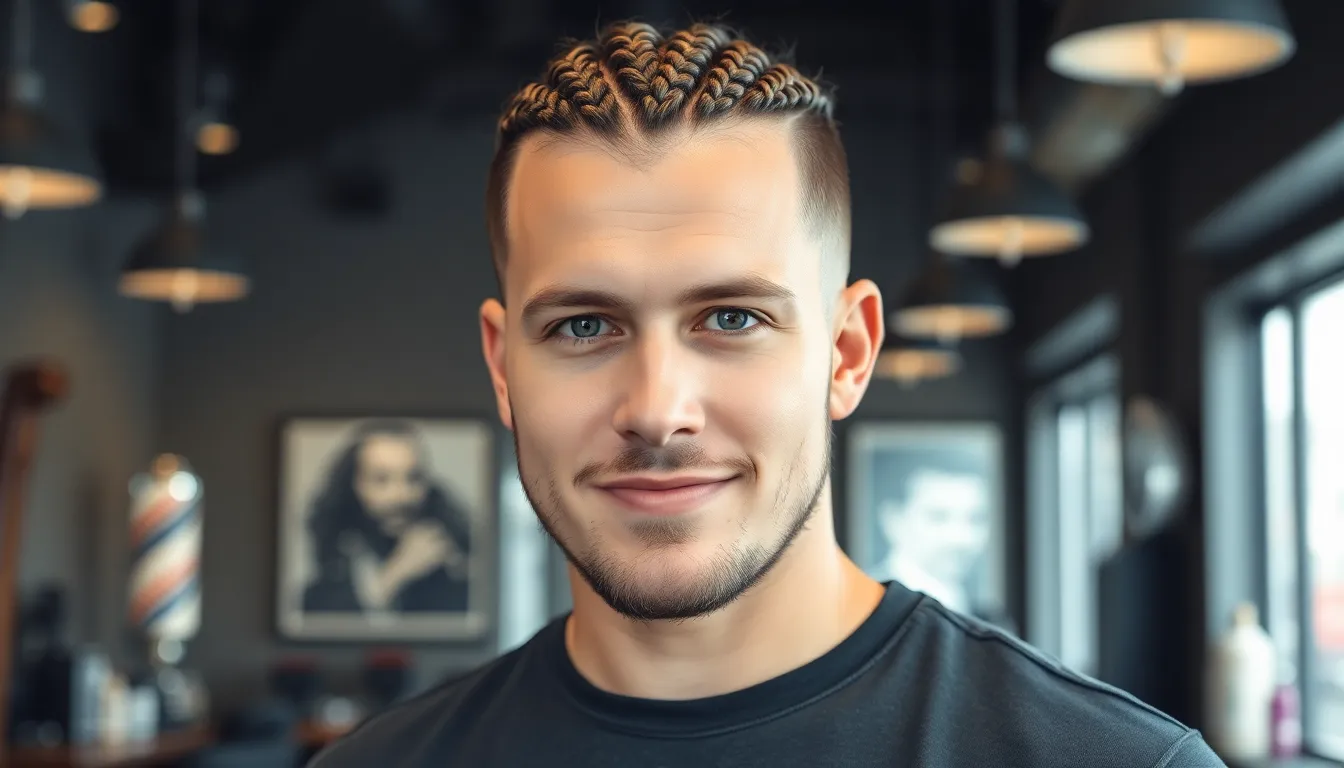
Viking braids with undercut fades represent one of the most striking combinations in contemporary men’s styling, merging ancient Norse warrior aesthetics with modern barbering precision. This powerful pairing creates an unmistakable masculine presence that’s captured attention across social media and barbershops worldwide.
Historical Inspiration and Modern Twist
Norse warriors originally wore intricate braided hairstyles that served both practical and symbolic purposes during battle and ceremonial occasions. These traditional Viking braids drew their power from the contrast between long, carefully woven hair on top and closely shaved or trimmed sides that enhanced their rugged appearance.
Modern interpretations transform these historical styles through contemporary fade techniques that create seamless transitions from skin to hair. The undercut fade modernizes traditional Viking aesthetics by replacing crude shaving methods with precise barbering that maintains clean lines and professional appeal.
Ragnar braids stand as the most iconic variation, featuring triple braids paired with shaved or faded sides that channel the aggressive warrior look popularized in contemporary media. We see this style dominating men’s grooming trends because it balances historical authenticity with current fashion sensibilities.
Side braids offer a subtler approach to Viking styling, incorporating smaller braids along the sides while maintaining the fade’s clean contrast. French braids adapted with undercut fades provide classic Viking styling with added modern flair that works across various professional and casual settings.
The integration of braids with undercut fades adds substantial volume and texture that creates bold, masculine appearances reminiscent of legendary Norse figures. This combination proves especially effective because the fade’s precision enhances the braids’ intricate details while maintaining practical wearability.
Beard Integration Techniques
Beard styling completes the Viking aesthetic by balancing the hairstyle’s boldness with complementary facial hair that enhances the overall warrior appearance. We recommend keeping beards groomed but full to match the style’s masculine energy without overwhelming facial features.
Beard oils and balms become essential tools for maintaining texture and shape that harmonizes with the braided hair above. Regular application ensures the beard remains healthy while supporting the rugged aesthetic that defines Viking inspired looks.
Some men choose to lightly braid their beards or style them to complement their hair braids, creating a cohesive warrior presentation that maximizes the style’s visual impact. This technique works particularly well with longer beards that can support intricate styling without appearing forced.
Blending beard length carefully with the fade’s transition maintains visual cohesion without creating competing focal points on the face. We suggest matching the beard’s fullness to the braids’ thickness while ensuring the fade provides clean contrast that defines both elements clearly.
The beard’s maintenance schedule should align with the fade’s touch up requirements, typically every 2 to 3 weeks, ensuring both elements remain sharp and well defined throughout the style’s wear period.
Twisted Braids With Shadow Fade
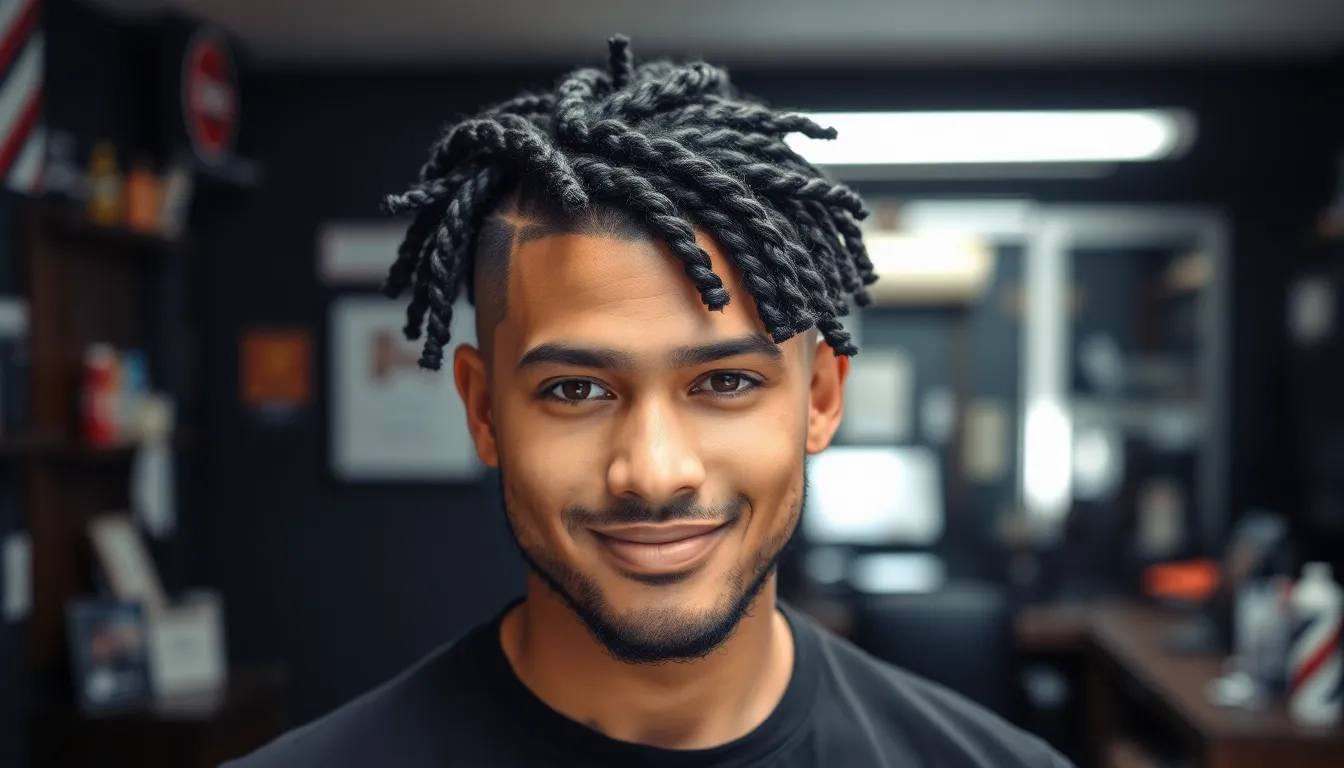
Shadow fades offer the perfect subtle transition for men seeking a softer alternative to the sharp contrasts we’ve explored with other fade styles. This gentle gradient creates an almost painted effect beneath twisted sections, blending seamlessly into the skin.
Two-Strand Twist Method
Creating twisted braids starts with mastering the foundational two-strand twist technique that works across all hair textures. We divide each section into two equal strands, then twist them around each other from root to tip in a consistent clockwise or counterclockwise motion. This method proves simpler than traditional braiding while delivering equally striking results.
Proper preparation involves detangling hair completely before sectioning to ensure smooth, even twists. We recommend working with slightly damp hair using a leave-in conditioner for better grip and definition. Starting at the scalp, we maintain consistent tension throughout each twist to create uniform patterns that complement the shadow fade’s subtle gradient.
The beauty of two-strand twists lies in their versatility—they can remain loose for a relaxed appearance or be secured at the ends for a neater finish. Each twist should measure approximately 1/2 to 3/4 inches in width to achieve optimal visual balance with shadow fade transitions. We suggest completing the fade first with your barber, then proceeding with the twisting process for the cleanest results.
Combining Multiple Twist Sizes
Variation in twist dimensions adds compelling visual interest to shadow fade combinations, creating depth and texture that enhances the overall design. Smaller twists measuring 1/4 to 1/2 inch create more defined patterns and deliver a sleeker appearance, while larger twists ranging from 3/4 to 1 inch offer fuller, more voluminous looks.
Strategic placement of different sizes maximizes the style’s impact—we often use smaller twists around the hairline and temples where precision matters most. Medium-sized twists work perfectly for the crown area, providing structural balance between the detailed edges and the statement sections. Larger twists positioned toward the back create beautiful contrast and allow for creative design possibilities.
Mixing sizes within the same style requires careful planning to maintain visual harmony with the shadow fade’s gentle gradient. We typically start with one consistent size throughout the top section, then incorporate varying dimensions in exact areas for artistic flair. This approach ensures the shadow fade enhances rather than competes with the twisted patterns above.
The key to successful size variation lies in maintaining proportional relationships between different twist dimensions and the fade’s transition zones. Gradual size changes work better than dramatic jumps, creating a cohesive look that flows naturally from the twisted sections into the shadow fade’s soft blend.
Braided Mohawk With Razor Fade
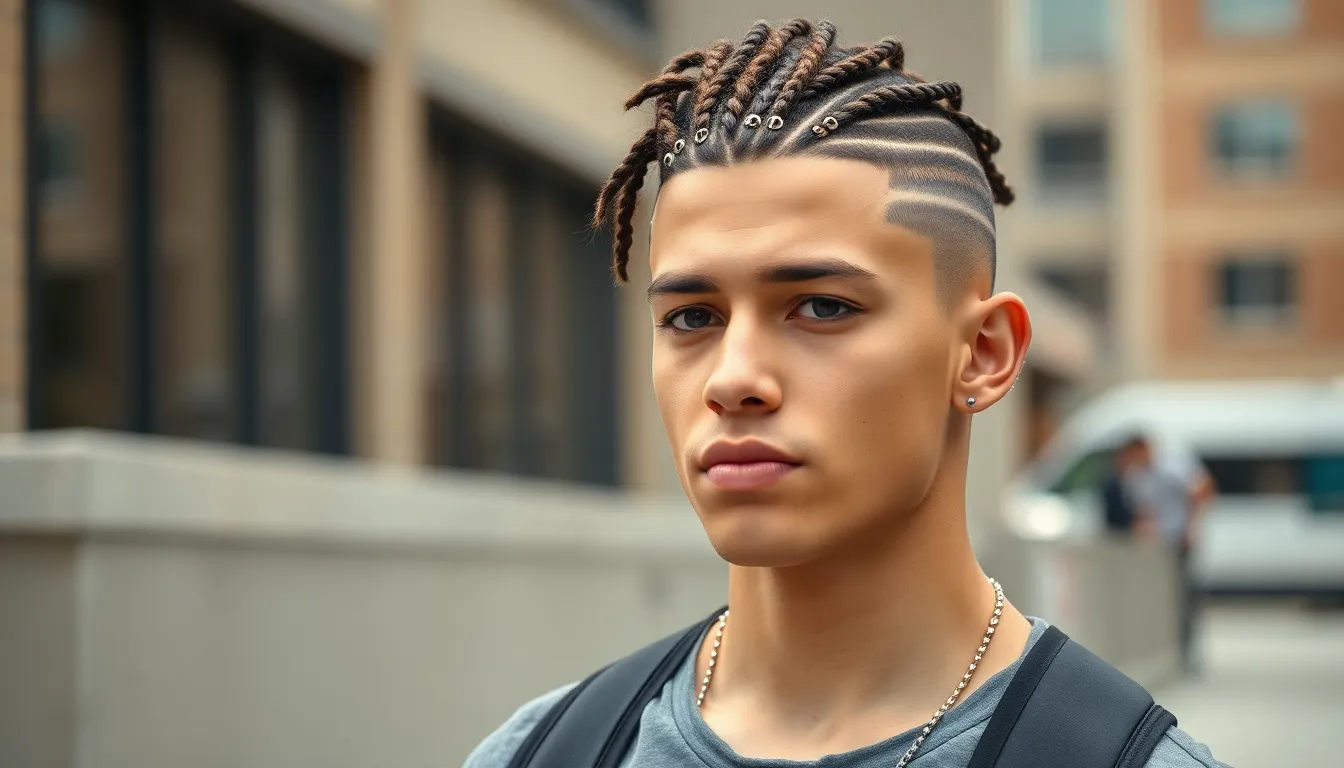
Building on the intricate styling options we’ve explored, the braided Mohawk with razor fade represents one of the most striking combinations in modern men’s hairstyling. This bold style merges the rebellious spirit of traditional Mohawks with the precision of contemporary barbering techniques.
Creating the Central Braid Strip
Preparation forms the foundation of achieving this dramatic look. Start with clean, slightly damp hair to ensure optimal grip and manageability throughout the braiding process. We recommend using a rat-tail comb to create precise sections that will define your central strip.
Sectioning requires careful attention to proportions and symmetry. Create a central pathway measuring 2 to 3 inches wide, running from your hairline to the crown. This width provides the perfect canvas for showcasing your braiding technique while maintaining balance with the surrounding razor fade.
Braiding technique can vary based on your personal preference and skill level. Regular three-strand braids offer a classic foundation, while fishtail braids create more intricate visual texture. We suggest starting with a standard braid if you’re new to this style, then progressing to more complex patterns as your technique improves.
Securing the braids properly ensures longevity and maintains the style’s sharp appearance. Use small, clear elastic bands that won’t compete with the overall aesthetic. Position these bands at the base of your neck to keep the braids secure without creating visible interruptions in the design.
Edgy Styling Variations
Undercut integration transforms the traditional razor fade into a more textured backdrop. This variation creates additional contrast between the braided central strip and the surrounding hair, emphasizing the Mohawk’s rebellious character while maintaining modern sophistication.
Side braid connections add complexity to the basic design by incorporating smaller braids that feed into the central strip. These connecting elements create visual interest and can be customized to match your face shape and personal style preferences.
Accessory enhancement elevates the basic braided Mohawk through strategic placement of small beads, metal rings, or colored threads. We recommend starting with subtle metallic accents that complement your skin tone before experimenting with bolder color combinations.
Length variations allow for personalization based on your hair growth and maintenance preferences. Shorter central braids create a more manageable daily style, while longer braids extending past the shoulders make a dramatic fashion statement that commands attention in any setting.
Conclusion
We’ve explored the ever-changing industry of braids with fades and discovered how these combinations create versatile looks that bridge tradition with contemporary style. From classic box braids with low fades to intricate micro braids with burst fades each pairing offers unique benefits for different lifestyles and preferences.
The key to success lies in understanding your hair texture face shape and maintenance commitment. Whether you’re drawn to the subtle elegance of twisted braids with shadow fades or the bold statement of a braided Mohawk with razor fade proper technique and consistent care ensure your style remains sharp and well-defined.
These modern interpretations of traditional braiding techniques prove that men’s hairstyles continue evolving while honoring cultural heritage. With the right approach and regular maintenance your braid and fade combination will keep you looking polished and confident in any setting.
Frequently Asked Questions
What are the most popular braid and fade combinations for men?
The most popular combinations include box braids with low fades, French braids with high fades, cornrows with mid fades, and Dutch braids with skin fades. These styles merge traditional braiding techniques with modern barbering, creating versatile looks suitable for various environments from corporate to creative settings.
How long do braids with fades typically last?
Most braided styles last 4-8 weeks, while fades require touch-ups every 2-3 weeks. Box braids can be maintained for 6-8 weeks, cornrows for 4-6 weeks, and micro braids slightly longer. The fade portion needs regular maintenance to keep the style looking fresh and well-defined.
What size braids work best with fade haircuts?
Medium-sized braids measuring 1/2 to 3/4 inches in width provide optimal visual balance with most fade styles. The size should be adjusted based on hair density and face shape. Smaller braids work well with skin fades, while larger braids complement low to mid fades effectively.
How do I maintain braids with fades between salon visits?
Use silk or satin pillowcases to reduce friction, wrap braids in a silk scarf at night, and apply lightweight oils to your scalp weekly. Keep both braided and faded areas clean and moisturized. Avoid excessive manipulation of the braids to prevent loosening and maintain the style’s longevity.
Can braid and fade combinations work for all hair textures?
Yes, braid and fade combinations are versatile and can be adapted for various hair textures. The braiding technique and tension may need adjustment based on your hair type. Coarser textures often hold braids longer, while finer hair may require different products for better grip and definition.
What products should I use for braided hairstyles with fades?
Use leave-in conditioner for moisture, hair gel or pomade for hold, and texturizing spray for grip during braiding. Heat protection products are essential when using styling tools. Lightweight oils help maintain scalp health, while flexible hold hairspray preserves the style without stiffness.
How long does it take to create intricate braid and fade styles?
Simple styles like box braids with low fades take 2-3 hours, while complex patterns like micro braids with burst fades can take 4-6 hours. Fishtail braids and Viking-inspired styles typically require 3-4 hours. Breaking the process into segments helps maintain quality and reduces fatigue.
Are there professional styling options for beginners?
Yes, beginners should start with simpler patterns like straight-back cornrows or basic French braids before attempting complex designs. Consider enlisting help from experienced braiders for intricate styles like micro braids or twisted patterns. Practice basic techniques before progressing to advanced combinations.
